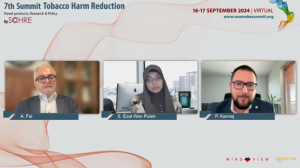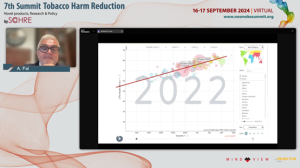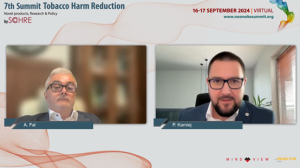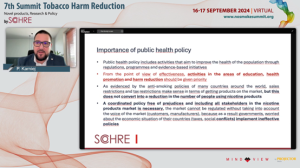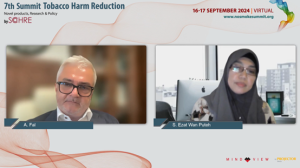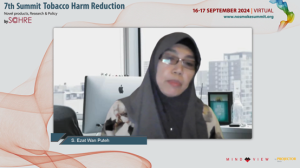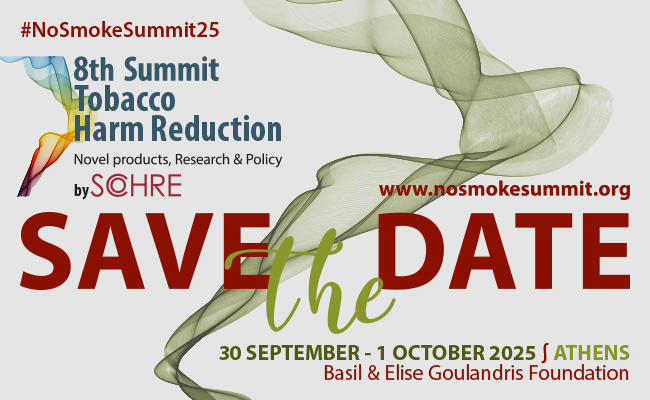The session, moderated by Professor Andrzej Fal, focused on the development of policy frameworks aimed at promoting public health by addressing behavioral risk factors, particularly concerning tobacco and alcohol use. Health literacy and health education came up first as key elements in protecting public health, and the speakers collectively underscored the need for stricter regulations and higher penalties to prevent tobacco sales to youth, alongside differentiated fiscal policies to limit access to harmful products.
In his opening remarks, Professor Andrzej Fal emphasized the need to address behavioral risk factors and the potential for saving on healthcare expenses through prevention efforts and highlighted the impact of alcohol and cigarette dependence on health; he also stressed the importance of viewing investments in lifestyle improvement as crucial for the future.
Life expectancy is not proportional but depends on the wellness of the society, Professor Fal said. The better we live in general, he explained, the more we spend on health, the longer we live. Today, according to recent data, we spend more for healthcare expenditures around the world than for education or military purposes, but there are still wars and plagues taking lives, and also NCDs that are prematurely taking lives. There are five major groups of NCDs linked to five major lifestyle behaviors. These are behavioral risk factors, and “behavioral means absolutely avoidable,” as he put it. It means that if we just change the way we behave, these factors could disappear—totally or at least partially. Prevention is getting more and more popular, he added, since every bad behavior has its price. In fact, prevention is an investment, not a spending. The money spent on improvement in lifestyle, on the fight against the behavioral risk factors, should be looked as an investment in the future. The lifestyle or the behavioral risk factors are not a story of a wolf in a forest, but a true danger.
The importance for early health education and promotion
Dr. Piotr Karniej highlighted the need to invest in health education in school children as early as possible. People need to be informed about the health hazards of smoking before they are addicted, but there must also exist other choices for those who are unable or unwilling to give up smoking, he stressed.
The most important problem of public health policies for tobacco control in Poland, Dr. Karniej said, is the limited effectiveness of actions taken in the areas of health education, health promotion and harm reduction.
Presenting data from a recent study regarding the consumption of nicotine products among 16–17-year-old young people, Dr. Karniej said that in Poland the sale of nicotine products to persons under the age of 18 is strictly prohibited. However, these products are purchased by teenagers, among others, via the gray market, social media, instant messaging and websites selling illegal nicotine products, as well as through friends or older colleagues. 62% of adolescents who use nicotine products have already taken up nicotine for the first time between the ages of 12 and 15, and most of them had already had experience with cheapest traditional cigarettes before reaching for disposable e-cigarettes. Therefore, he underlined, the results of this study do not confirm that alternative nicotine products are the first products of nicotine initiation in adolescents.
According the same report, the most common reason for young people to use nicotine products is to relieve stress, as cited by 60% of respondents in the 16-17 age group. This points not only to the need for preventive measures in the context of nicotine use, but also in the context of psychiatry, coping with stress and relieving tension. Young people, the speaker stressed, are not able to cope with everyday tension and stress. More than half of those respondents will not give up e-cigarettes if they disappear from legal outlets. 49% of respondents will stop using them, but 20% will look for other products of this type and 32% will look for other distribution channels, which opens the path for illegal imports of nicotine products from countries like China.
Governments all around the world, Dr. Karniej concluded, must take into account the real and not the imaginary circumstances of tobacco use, including of products available through illegal channels. Unfortunately, the actions of international organizations and governments that antagonize the market for the sale and consumption of nicotine products are unacceptable, as they do not take into account harm reduction policies and do not lead to consensus.
The success story of Malaysia and the new challenges
Professor Sharifa Ezat Wan Puteh delved into the complexities of promoting tobacco harm reduction in Malaysia, highlighting the challenges faced in convincing policymakers and the public about the effectiveness of harm reduction strategies. She also presented results from Malaysia that managed to greatly reduce smoking rates in the last years, and explained that the key success factors were education, the establishment of an effective legal framework, and law enforcement. Nevertheless, she highlighted the problems of the high prevalence of illicit cigarettes and the emergence of e-cigarettes mixed with drugs as a concern for public health.
Tobacco harm reduction is not very popular in many countries, including Malaysia, Professor Wan Puteh said. Most of the government societies, such as the National Cancer Society, do not believe that harm reduction is an effective tool, and this hinders public health promotion and transferring of knowledge. Even reports showing the DALYs, the life years that can be saved, and the cost effectiveness of THR, comparing alternative nicotine products such as e-cigarettes, with NRT, and combustible cigarettes, can’t convince some of them. Many government societies have adopted the perfectionist view, according to which no form of tobacco and use of nicotine should be allowed. For tobacco addicts, they only propose NRT, which can be purchased over the counter from pharmacies, but does not really work in the real world, she commented. It is necessary to convince Malaysia’s policymakers to consider tobacco harm reduction as public health priority and to educate the public.
Malaysia several years ago had a huge problem with the amount and percentage of smokers, Professor Fal commented. And now the country is doing quite well, especially when compared to the neighboring countries, such as Indonesia, he said, and asked Dr. Wan Puteh to present to the audience Malaysia’s story of success in tobacco control.
Tobacco control policies in Malaysia are relatively quite good, Prof. Wan Puteh said, the key elements of their success being education, training, and law enforcement. Enforcement is quite strong, she explained, and takes a lot of the country’s budget. Unfortunately, there is also a high percentage of illegal cigarettes in the region. In fact, one in two smokers of combustible cigarettes is using illicit cigarettes that come mainly from China, but also from Indonesia and Myanmar. These cigarettes are relatively cheap, just about one tenth of the price of legal cigarettes. Another problem that today Malaysia faces, she said, is that, although the percentage of male smokers diminishing and most of them have transitioned into e-cigarettes, unfortunately there are a lot of vendors who are mixing e-cigarettes with psychoactive drugs, such as cannabis—an extremely worrisome fact. Using illicit vape mixed with drugs causes a lot of damage to the tobacco harm reduction concept, since THR is being targeted as promoting mixing drugs with the vape. Actually, the vape is just a mechanism people use together with a lot of things: vitamins, caffeine, and in Malaysia also with drugs. THR advocates are against this and keep telling people that vape is to be used to reduce the harm of combustion in tobacco, not to experiment with drugs. Unfortunately, even though the enforcement is strong, there are still leakages into the country, where a lot of the illicit drugs are being sold together with vape, even to the youngest consumers, meaning that school children are also using this. This is a big problem that hampers our drive to promote public health, the speaker concluded.
Discussion
Professor Fal thanked Dr. Wan Puteh for her presentation and commented that Malaysia’s success seems to be based on primordial education at the kid level, good law and law enforcement, and a developed harm reduction market. With these three elements acting together, the country succeeded in cutting the smokers within 15 years by 60%. This is a success, although, obviously, the country has still a very long way to go, Professor Fal added, and asked the speaker’s point of view regarding the problem that many young people use harm reduction techniques or devices to initiate smoking.
It is true that in Malaysia there is still a small number of youngsters who initiate e-cigarettes or vape at a young age without having any prior nicotine experience, Professor Wan Puteh replied. On the other hand, the country has a very strong education system, which basically deters the students from using e-cigarettes, by disciplining them, catching them in the act and preventing them from bringing vapes in schools. However, we do realize that most of the students or young people that use these products, do it because they want to switch to a less harmful substance, meaning they want to switch because they used to smoke. There is actually an age verification process if they go to legal stores, she added. Customers have to show their ID and have to be 18 years old or older to purchase e-cigarettes.
Taxation and fiscal policies for tobacco products
Andrzej Fal and Piotr Karniej delved into the governments’ use of fiscal tools, such as taxation, to influence behaviors related to cigarette smoking. They emphasized the need for a clear strategy from governments, especially in differentiating taxes for traditional cigarettes and nicotine alternatives, and in addressing the issue of underage use of nicotine products. Additionally, they stressed the importance of understanding the perspective of nicotine companies and the evolving global market.
Governments have many tools, including fiscal tools, which can promote or discourage behaviors, including cigarette smoking. And especially in the past few years in Poland, there is a huge ongoing discussion on how both alcohol and cigarettes should be taxed, Professor Fal said and asked Dr. Karniej to share his thoughts about the matter.
This is an important issue, Piotr Karniej said, because taxation and fiscal differentiation of the tobacco products help governments to decide the cost of each product. In reality, there are two choices: either you promote traditional cigarettes keeping them cheap, or you decide that nicotine alternatives are better, and you promote harm reduction. The problem is that our governments, especially the Polish one, have not yet taken a decision. So there isn’t a clear strategy and every discussion is understood as kind of lobbying.
From my perspective, Dr. Karniej underlined, it is very important taxation of traditional cigarettes and nicotine alternatives to be differentiated based on their influence on the society. A second very important policy is banning the selling of nicotine products to people who are under 18 years old. And last but not least, is to tax income from the selling of the products. We must understand, the speaker said, that tobacco companies are very important companies in the global market. So, we have to talk to them and to try to understand, not only the perspective of the government, but also their perspective, because the world is changing, the whole market is changing, and they are changing too.
Strategies for Tobacco Control and Harm Reduction
Regarding the strategies that could be more useful for tobacco control, Andrzej Fal stressed the importance of updating policies and early health education to address the rising percentage of daily smokers in Poland, and advocated for higher penalties and prohibition of sales to youngsters for all harmful substances or techniques. Professor Sharifa Ezat Wan Puteh advocated for harm reduction as part of the strategy to reduce harm from tobacco, encouraged the use of alternative nicotine products, and she recommended three strategies for reducing tobacco harm in Indonesia, including implementing harm reduction strategy and proportional taxation on alternative nicotine products. Piotr Karniej discussed the challenges of convincing patients and stakeholders about the importance of health education, and proposed the establishment of a well-trained team of health educators to address these challenges.
Twenty-five years ago, Poland had one of the best anti-nicotine policies and we had huge successes as a country, Professor Fal said, but the same regulations, the same ways, the same attitude that were effective at the beginning of the millennium are not effective anymore. The last report published a year ago by the Polish Academy of Sciences says that the percentage of daily smokers in Poland reaches 30%, much more than in the past 15 years. So, the country is not going in the right direction. Professor Fal stressed that early health education can make a difference, can influence attitudes.
Professor Sharifa Ezat Wan Puteh said that if she was to advise her own government for policies that could, in her opinion, decrease even more the number of cigarette smokers in the country and improve the population’s health, she would propose three strategies: To reduce risk factors for NCDs and especially tobacco, to look at harm reduction as part of the strategy to reduce harm from tobacco and support the use of alternative to combustible cigarettes products, and, third, to examine the economic aspect and use the tax that can be taken from e-cigarettes to build up the healthcare system. But, she clarified, the tax needs to be proportionate, since if it is very high the population will return to combustible cigarettes.
Poland, right now, faces a lot of challenges, Dr. Piotr Karniej said, one of which is the organizations who are questioning science. Therefore, a significant problem is to convince both patients and stakeholders, including the government, that science and the information it can offer is important. He also proposed to focus on health education and health promotion and to prepare a very good “army of health educators”.
There must be higher penalties and prohibition of sales to the youngsters should be stricter, Professor Fal stressed. Otherwise, the concept of harm reduction is losing a lot, since on one hand we are reducing harm, on the other we are opening the door for some harm. Another important aspect, he continued, is that even in the group of substances or techniques that are being called “harm reducers”, there are differences, and these differences must be strengthened by both education and fiscal policy of the government. There are very technically advanced devices which will never become so cheap to be available to all junior students, because this part of the market is very price sensitive. Therefore, issuing new regulations on excise tax and making all the products less available—but especially the most harmful absolutely not available—could be also one of governments’ priorities, Professor Fal concluded.
